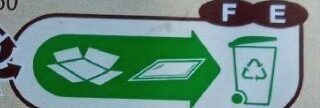Chocolat noir aux éclats de fèves de cacao - Carrefour Bio - 100 g
Aquesta pàgina del producte no està completa. Podeu ajudar a completar-la editant-la i afegint-hi més dades a partir de les fotos ja disponibles, o fent-ne més amb l'aplicació de androide o iPhone / iPad. Gràcies!
×
Algunes de les dades d’aquest producte les ha proporcionat directament el fabricant Carrefour.
Codi de barres: 3560071265533 (EAN / EAN-13)
Nom comú: Chocolat noir aux éclats de fèves de cacao, issu de l'agriculture biologique. Pur beurre de cacao.
Quantitat: 100 g
Marques: Carrefour Bio, Carrefour
Categories: Snacks, Aperitius dolços, Cacau i derivats, Xocolata, Xocolata negra, en:Dark chocolates with cocoa nibs
Etiquetes, certificacions, premis:
Orgànic, Orgànic UE, Agricultura No-UE, IT-BIO-014, Comptador Nutricional, Grau D NutriScore, Mantega de cacau pura, AB Agriculture Biologique

Origen dels ingredients: No Unió Europea
Productor: Prodotto da ICAM S.p.A., nello stabilimento di via Caio Plinio 5/7 - 22030 Orsenigo (CO) Italy per Interdis - TSA 91431 - 91343 MASSY Cedex - France
Botigues: Carrefour, carrefour.fr
Matching with your preferences
Altres dades
Condicions de conservació: Conservation : À conserver à l'abri de l'humidité, de la chaleur (entre 18°C et 20°C) et d'odeurs parasites. Pour une dégustation optimale, à consommer de préférence avant le : / N° de lot : voir sur cette face.
Report a problem
Fonts de dades
Producte afegit per kiliweb
Última modificació de la pàgina del producte per thaialagata.
La pàgina del producte, també editada per chevalstar, driveoff, inf, moon-rabbit, openfoodfacts-contributors, org-carrefour, quechoisir, roboto-app, teolemon, yuka.sY2b0xO6T85zoF3NwEKvllQWXIHgnD7dNgH4khy04eihMcXuMfZ-8NH1P6s, yuka.sY2b0xO6T85zoF3NwEKvlmNkSoWCnjHtMgbgmECq-dGhD7DzRvxowKjQaas, yuka.sY2b0xO6T85zoF3NwEKvlmdreuGCnTyfDz_jgm-v4v6rE43nev4i2Kqlbqo.












